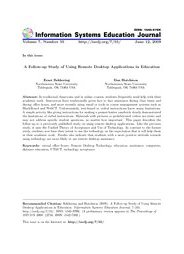Volume 7
Volume 7, Number 55 |
June 12, 2009 |
Abstract: In traditional classrooms and in online courses, students frequently need help with their academic work. Instructors have traditionally given face to face assistance during class times and during office hours, and more recently using email or tools in course management systems such as BlackBoard and WebCT. Unfortunately, text-based or verbal instructions know many limitations. A simple activity like giving instructions for making a peanut butter sandwich clearly demonstrated the limitations of verbal instructions. Materials with pictures or prefabricated videos are static and may not address specific student questions, no matter how important. This paper describes the follow-up to a previously published study on using remote desktop applications. Like the previous study, it uses the Unified Theory of Acceptance and Use of Technology. In contrast to the former study, students now base their intent to use the technology on the expectation that it will help them in their academic work. Results also indicate that students with a more positive attitude towards using technology are more likely to use remote desktop assistance.
Keywords: virtual office hours, Remote Desktop Technology, education, assistance, computers, distance education, UTAUT, technology acceptance
Download this issue: ISEDJ.7(55).Bekkering.pdf (Adobe PDF, 13 pages, 779 K bytes)
Preview the contents: Bekkering.j.txt (ASCII txt, 35 K bytes)
Recommended Citation: Bekkering and Hutchison (2009). A Follow-up Study of Using Remote Desktop Applications in Education. Information Systems Education Journal, 7 (55). http://isedj.org/7/55/. ISSN: 1545-679X. (A preliminary version appears in The Proceedings of ISECON 2008: §2734. ISSN: 1542-7382.)
